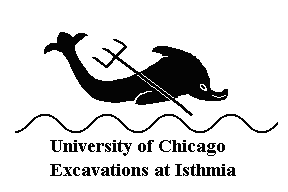UNIVERSITY OF CHICAGO EXCAVATIONS AT ISTHMIA, 2007
SITE and MUSEUM:
Renovation of the site and museum through a grant from the European Fund for Rural Improvements and Third Community Support Budget is the major project at Isthmia this year. Completion is scheduled for the end of 2007 or early in 2008, and all colleagues involved in the Isthmia publications have devoted themselves to preparing plans and texts for the displays. Vasili Tassinos and Maria Kechrinioti are responsible for the installation with the aid of conservator, Angeliki Kandri, and Nikolaos Rothonis and Miltos Charitos. The project is administered by the Λ Ζ (37th) Ephoreia of Prehistoric and Classical Antiquities of the Hellenic Ministry of Culture under the direction of the ephor, Dr. Konstantinos Kissas.

The Isthmia Museum.
Climate control, repairs to the structure and installation of new displays in the exhibit hall improve the conservation and presentation of the antiquities. New plans and restored views by Fritz Hemans (architect), Peggy Sanders (computer graphics) and Judith Stowell (water colors) will enable the public to visualize the sanctuary over more than a millennium of its history. Objects are placed in their archaeological and historical context through explanatory texts accompanying the graphics with the overall goal of helping the viewer to make a bridge between the site and the artifacts on display. The site administrator, Jean Perras, coordinates all aspects of the project.

M. Kechrinoti, V. Tassinos, A. Kandri, I. Kordos, J. Perras.
CONFERENCE: “Half a Century on the Isthmus”
On 15-17 June 2007 Chicago joined with the Ohio State Excavations (Timothy Gregory, director) to present a conference commemorating Oscar Broneer’s discovery of the Temple of Poseidon in 1952 and the excavations that followed: “Half a Century on the Isthmus: A conference to celebrate over fifty years of excavation and survey on the Isthmus of Corinth”. The twenty-two papers read by members of the Chicago and Ohio State teams and the EKAS Survey project presented new discoveries from excavation material they are preparing for publication. A volume of the proceedings is planned.

Isthmia Excavation Staff, May 1960.
D. Papaioannou (foreman), David Mitten, Joe Shaw, Jim Wiseman, Oscar Broneer, John Hawthorne, Betsy Gebhard, Katina Sophou (cook) Ione Shear, the Guard.
Archaic Temple: Fritz Hemans
Plans for the museum layout and text for the Archaic Temple were finalized. For construction of the temple walls, evidence is deduced for the use of a simple crane.

Construction of the temple wall using a crane.
Late Archaic and Classical ceramics: Martha Risser, Katy Nolin
Types of vessels presented as votives in the Temple of Poseidon and within the temenos and the wares used for food preparation and feasting after the sacrifices were distinguished through a comparison of pottery from the Classical terraces and the temple in relation to material from the reservoir (Great Circular Pit) in the area reserved for dining.

Martha Risser.
Inscriptions: Klaus Hallof, Peter Funke
Continuing the work of the late Michael Jameson, Hallof made squeezes of 65 fragments from four documentary stelai of the 2nd century B.C, and prepared a transcription of the texts, while Funke worked on the historical context of the decrees.

Klaus Hallof.
The Rachi Settlement: Virginia Anderson-Stojanovic
Further study of the remains assigned to Houses III, IV, V, and VI showed that in fact there were only three houses. The domestic structures conform to a generally consistent size between 60-75 m2 . Analysis of the activities and their location in the settlement was undertaken through distribution tables for objects such as stone vessels, lamps, terracotta figurines, loomweights, perirrhanteria, and votive pottery.
 |
 |
| Artist’s Restoration of the Rachi Settlement as seen from the sanctuary. |
Plan of the Rachi Settlement.
Artist’s Restoration of the Rachi Settlement as seen from the sanctuary.
Terracotta Figurines: Arne Thomsen
distinct types were defined: individualized figurines of early and high Archaic date, and a group of “standardized” horses close to the ‘Late Group’ from the Potters’ Quarter at Corinth belonging to the 5th and 4th centuries B.C. The later Isthmian horses are not entirely dependent on Corinth and may provide a better understanding of the development of the typical ‘Late Group’ horse.

Terracotta Horse Figurines.
Coins: Liane Houghtalin
Approximately 900 coins from the Chicago Excavations and 600 from the UCLA/Ohio State expedition are being prepared for a single publication. To aid in making a detailed study of the types, the Chicago collection was photographed using a digital camera producing over 3000 digital images. Coins needing further conservation were recorded and will be treated in the coming year.

Gold Darics.
Palaimonion Elizabeth Gebhard
To aid in identifying the sculptural program under study by Mary Sturgeon and the context of other objects from the west precinct of the Palaimonion, the elevations of the floors, later removed, were documented: Phase III (Hadrianic) ca. 0.38 m. to 0.60 m. above the underlying stadium floor; raised in Phase V (Antonine) to ca. 1.25 m. above the stadium. first century of Roman cult activity.

Excavations in the west precinct of the Palaimonion, 1956.
Arms and armor: Alastar Jackson, Irena Marszalek
Indications emerged that sometimes the armor dedicated to Poseidon was in less good condition than that offered to his elder brother Zeus at Olympia. A repair patch was found to fit exactly in the top of one of the helmets, showing that the helmet had been damaged, repaired and continued in use before being dedicated.

Arms from the Age of Alexander.
Iron weapons belonging to the second half of the 4th century B.C. from a funerary monument southwest of the sanctuary (the West Foundation) were found to closely resemble arms from tombs at Vergina and Derveni. They seem to reflect Macedonian influence at Corinth and Isthmia from the time of Philip II and his successors.
Late Hellenistic and Roman ceramics: John Hayes, Sara Strack
The manuscript is in the hands of the director and project editor, Sara Strack.

Jean Perras and Angeliki Kandri in the Isthmia office.

